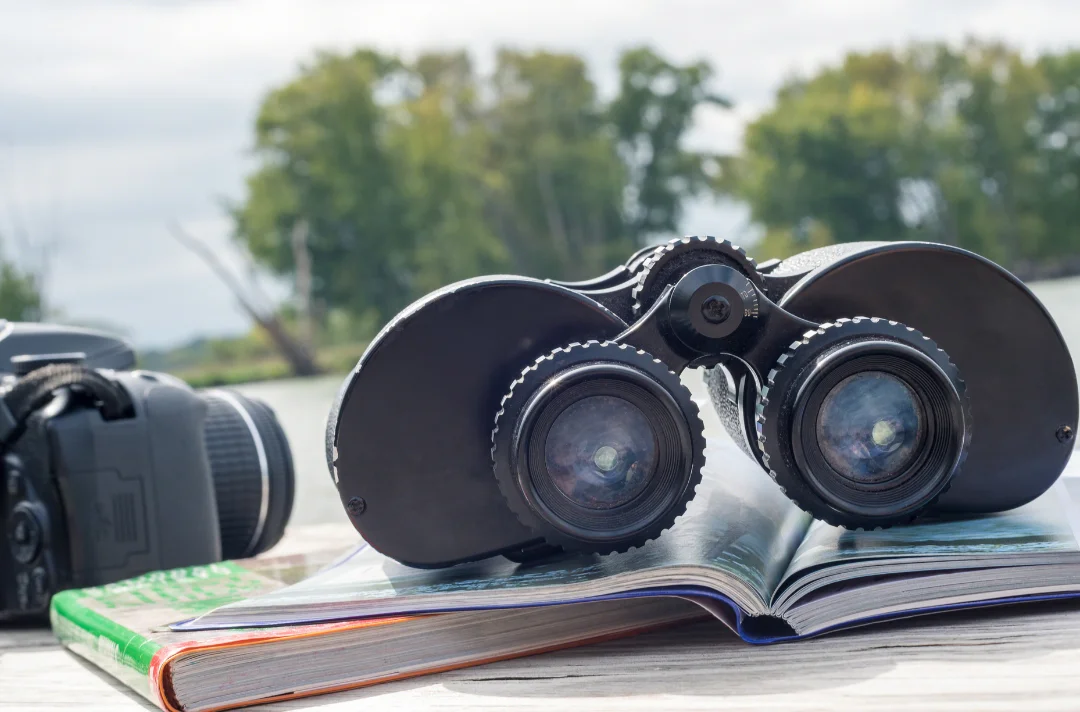One of the most exciting things for a naturalist is running into new and unfamiliar species. This makes field guides an essential part of any nature-lovers go-bag for outdoor adventures. Field guides can help you sleuth out and identify new encounters using field marks and other cues. In this Birdwatching Basics post, I’ll review my top 5 guides to the birds of North America and walk you through what to look for.
With over 700 breeding bird species in the U.S. and Canada alone, North America is home to a fantastic array of feathered wildlife. This makes field guides super important, whether you live in the U.S., Canada, or Mexico, or are planning an outdoor adventure.
Field Guides: A Birding Essential
Although outdoor apps like Merlin can greatly enhance your birdwatching experience, there’s no replacement for the right field guide. Of course, apps are a heck of a lot lighter than books, and you can store several on your phone for reference. Many of them also have bonus features like recordings of birdsongs.
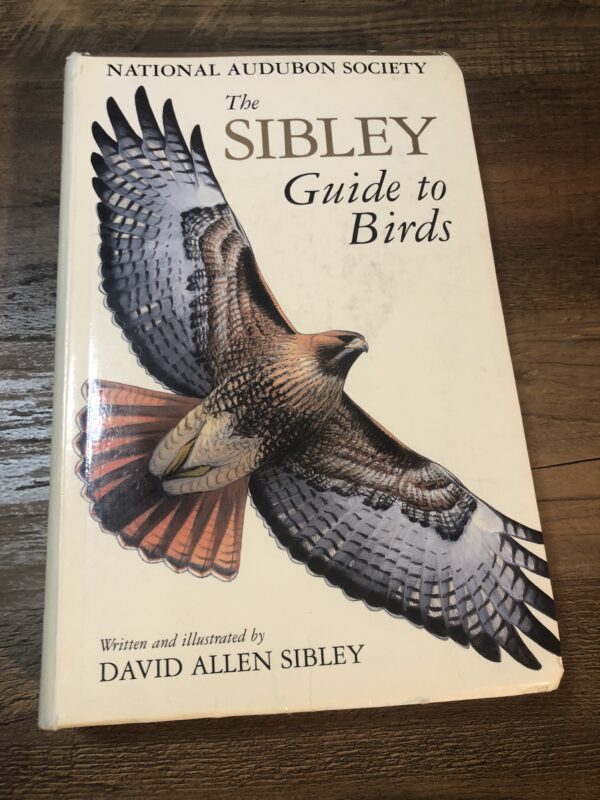
However, field guides are often quicker to navigate than online or app guides, and aren’t going to break if you drop them! Furthermore, they won’t drain your battery, or need phone reception in remote areas. If you’re like me, it also just feels better to hold a book and turn the pages yourself.
Even if you prefer to use digital field guides, it can help to have hard copies waiting for you at home as references.
Some things to look for
Not all field guides to birds are the same, and it’s important to figure out which one is best for you. While many die-hards will own multiple field guides to the same region, this can get expensive fast! Here are some things to consider when choosing a field guide to suit your needs:
- Locations of maps & images (AKA plates): Are they on the same page as the species’ descriptions, or at the back of the book? Will you be flipping through this book in a hurry, or studying at home before you go out?
- Size and weight: Do you need a book to fit in a backpack or in the glove compartment of your car? Are you trying to manage weight for distance hiking?
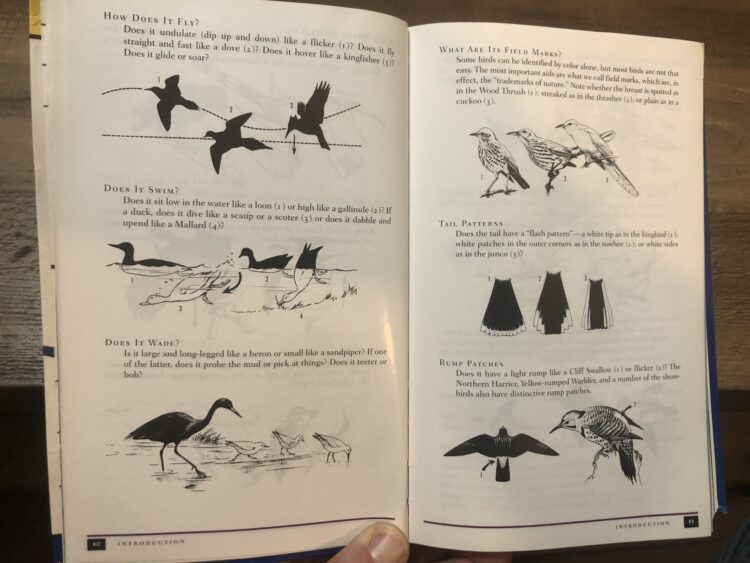
- Birding tips, tricks, and quick guides: Many guides have helpful charts and beginner birding tips before the body of the text.
- Photographs vs. drawings: Do you need a more generalized idea of a species’ appearance from idealized drawings? Are specific photographs more helpful? If you have a good grasp of many species’ field marks already, photographs may be a better option. By contrast, illustrations are helpful for beginners because they highlight key features.
- Geographical coverage: Do you want a detailed guide to one area? Would you prefer a more general guide, even if it might be missing some species? The bigger the coverage, the bigger and heavier the book!
- Most recent edition: When was he last time this series was updated? Are you getting the latest version?
1. The Sibley Field Guides to Birds of North America
David Allen Sibley quickly rose to legendary status among American naturalists and outdoor artists. The biggest advantage to his series of carefully researched guides is his stunning prints. Specifically, they highlight key field marks, shapes, and even subtle movements that help distinguish between species.
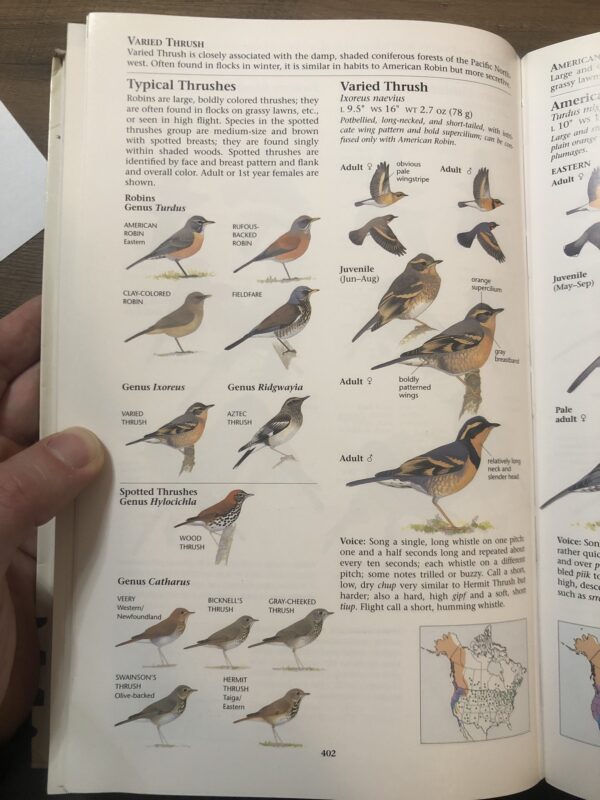
Sibley’s keen naturalist eye is clear throughout the guide and makes it a favorite for beginner as well as expert birders. There are at least three major versions of Sibley’s guide to North American birds:
The Sibley Guide to Birds, which covers all of North America
Sibley Birds East, which covers the East coast inland to around Texas
Sibley Birds West, which covers the West coast, Rocky mountains, and Desert west.

Sibley guides start with a great introduction to the ecology and natural history of birds, as well as factors that affect their identification. It also features tips on ethical birding and helpful images showing the “topography” or a bird. In other words, a helpful map of the average bird and the names for different parts of its body.
Species accounts in Sibley guides are pretty in-depth, which helpful illustrations of species in different plumages. Additionally, they may feature helpful contrasts with similar species, and sketches of common behaviors or postures that can be super helpful.
The birds in Sibley guides are organized taxonomically, that is, by their evolutionary relationships. This organization may require some prior experience to navigate freely.
Sibley guides, especially the unified edition of all birds in North America, tend to be a bit bulky. They are excellent reference texts but not always fun to lug around in the field!
More from Sibley
If you’d like to hear more from Sibley, check out our interview on the Nature Guys podcast about his recent book, What It’s Like to Be a Bird.
2. The Crossley ID Guides to Birds of North America
Richard Crossley is an all-star British birdwatcher with a different take on field guides to bird species. His guides follow an approach he calls “reality birding”. Specifically, they are meant to more accurately portray the images that a birdwatcher is likely to encounter outside. For starters, this means using photographs rather than illustrations.
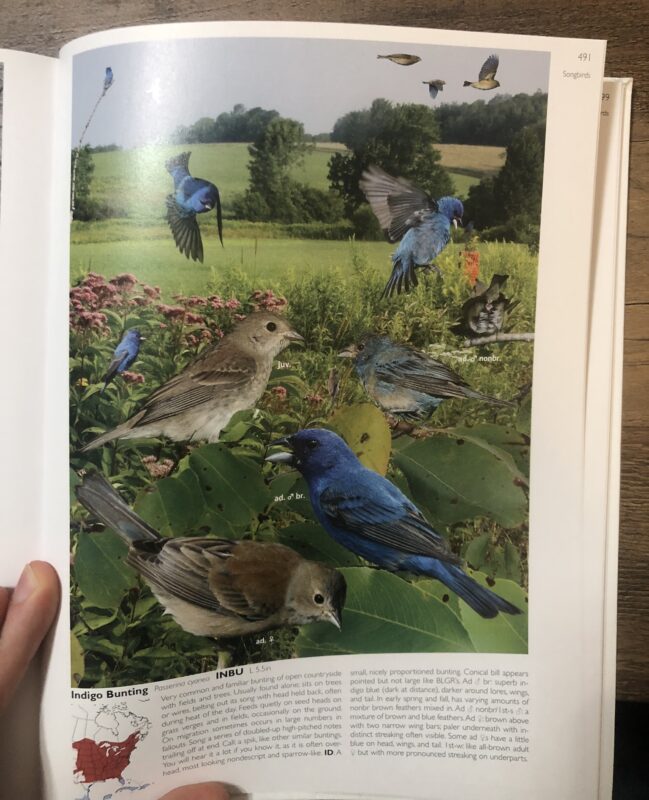
Secondly, this means overlaying those photos on real background photographs of typically environments that the species is found in. Thus, Crossley ID guides help you not only identify the species but the locale in which you’re likely to find it.
Unlike many other guides, Crossley guides are organized based on broadly observable characteristics of the birds. For example, if you see a bird zooming around over a field, you might start with “flying landbirds” and go from there. This can make it much easier to find what you’re looking for than the taxonomic organization.
Species accounts or plates in Crossley guides focus on big, expansive, and layered photographs. As Crossley commented, “I don’t like text.” Because of that, you might not get as much written description of birds in these guides compared to others.
Although divided into East and West like other bird guides, all Crossley guides are big and heavy. They might be better to store in your car or home library than lug around in your backpack.
Crossley ID Guide: Western Birds

Crossley ID Guide: Eastern Birds
3. The Peterson Guides to Birds
The Peterson field guides are some of the oldest and most well-known nature guidebooks to North American birds. Roger Tory Peterson was a phenomenal naturalist, birdwatcher, and artist who inspired generations of American naturalists. After many editions, his field guides are still a mainstay of birdwatchers’ bookshelves all over the country.
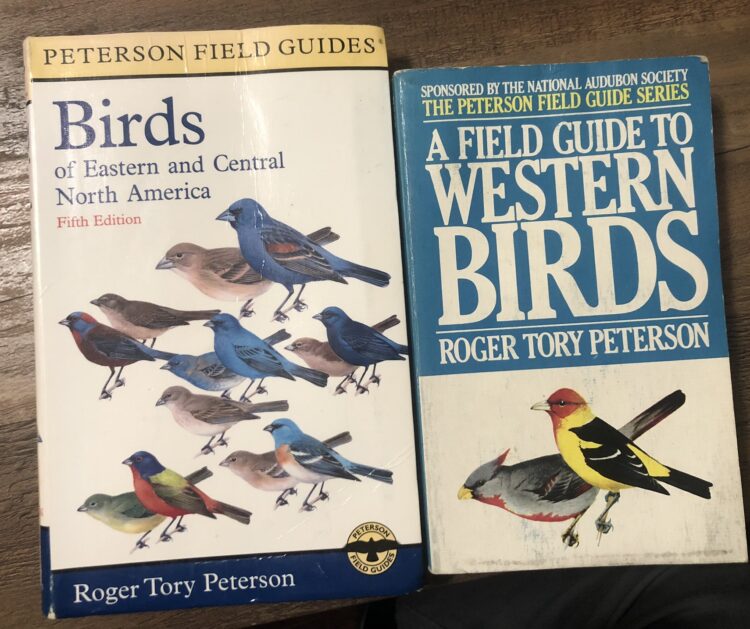
Peterson guides are illustrated, much like Sibley guides, but typically have fewer illustrations per species. Although organized taxonomically, they have convenient guides to bird silhouettes and behaviors that can guide readers to different book sections.
Individual species accounts are typically mixed within a page, with closely related birds grouped together. This compact format helps save a lot of space. The result? Peterson field guides are among the most portable and can easily be carried around. My own Peterson guide has very obviously come with me on some adventures! Of course, the downside is that in-depth information isn’t available for every species, and range maps are typically at the back of the book.
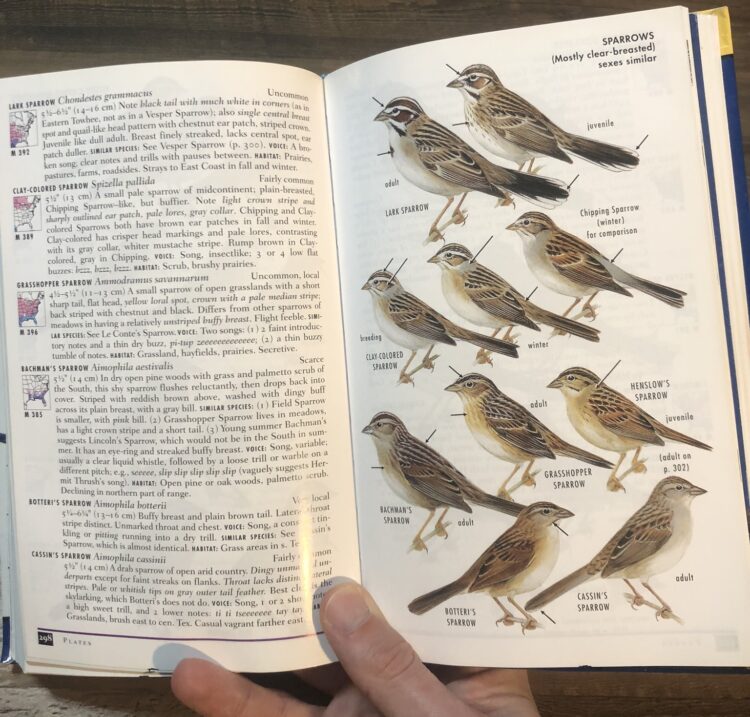
Peterson guides also have a lot of great info for beginning birders in the introductory chapters, and a neat checklist that you can use to keep track of bird species that you’ve seen.
The Peterson Field Guide to Birds of Eastern & Central North America
The Peterson Field Guide to Birds of Western North America

More than just birds!
Another major advantage of Peterson bird guides is that they share a format and style with guides for other kinds of wildlife as well. If you like the Peterson style, you can also get matching field guides for things like:
- Trees
- Butterflies and Moths
- Freshwater Fish
- Reptiles and Amphibians
- Bird Sounds
- Bird Nests
- Medicinal Plants and Herbs
- Rocks and Minerals
- Mammals
- Insects
- Mushrooms
4. The Kaufman Field Guide to Birds of North America
Ken Kaufman’s guides focus above all on being user-friendly. As early as the table of contents, these books feature photographs of representative birds for each group. These are interspersed with helpful tips and directions for what to do when you see a bird that you don’t know.
These guides provide lots of great tips for absolute beginners, including how to use binoculars and common field marks for identifying birds.
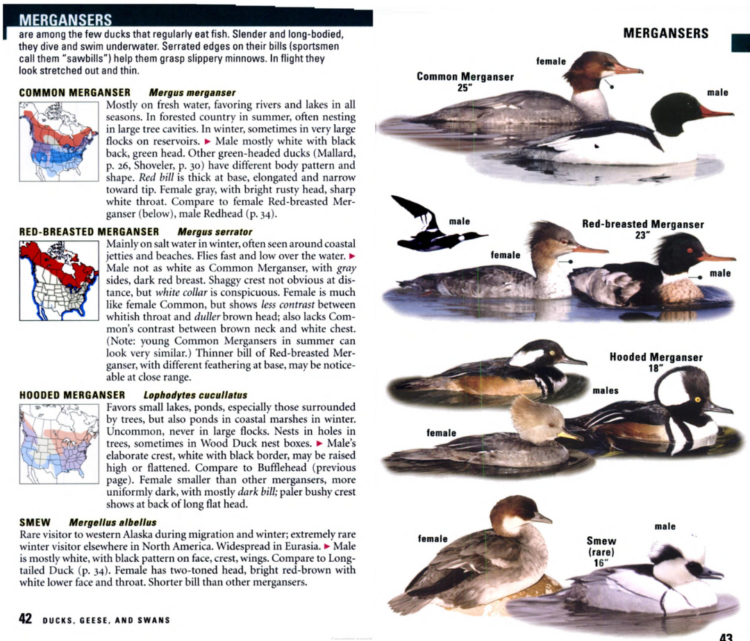
Kaufman begins each section with a whole bunch of photos on birds within a group to help readers narrow down their choices. These guides use photographs, not illustrations, and group photographs to make it easy to compare species. Each species also has a short blurb with information on their range and vocalizations.
Their compact design and relatively low number of images compared to other guides makes Kaufman guides compact and portable. This is impressive considering that the book covers both East and West!
The Kaufman Field Guide to Birds of North America
Other great Kaufman guides
Like Peterson guides, there are Kaufman guides available for other aspects of nature if you really like their style. Here are some others that I’ve enjoyed:
- Kaufman Field Guide to Butterflies of North America
- Kaufman Field Guide to Insects of North America
- Kaufman Field Guide to Nature of New England
- Kaufman Field Guide to Advanced Birding
5. National Geographic Field Guide to the Birds of North America
The National Geographic field guide is remarkably portable and compact for the number of species it covers. It features hundreds of excellent illustrations for the vast majority of species you might come across in North America.
Like other guides, it also has great coverage of beginner tips, bird behavior and biology that will help you started. For the amount of information it carries, it’s a book you can drag around with you easily.
However, its species descriptions are pretty short, and don’t include a lot of behavior or other natural history information. The various illustrations are also done by a number of different artists, which can make them hard to interpret for beginners.
The Nat Geo guide’s main advantage is cramming a lot of info into a small guide that you can take around with you. It’s a good one for a quick reference but might not have the depth of information needed for detailed identification.
National Geographic Field Guide to the Birds of North America
Thanks for reading about guides to the birds of North America!
Do you have a favorite field guide that you’d like to see featured here? Have you had a good experience with one of these guides? Let us know in the comments, or feel free to reach out using the Contact page. Thanks!

